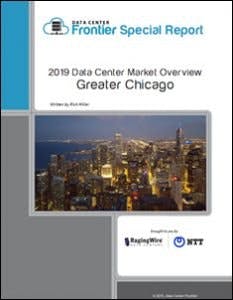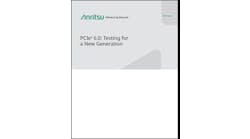Chicago Data Center Market Boosted By New Economic Incentives
We continue our series of stories on the leading geographic markets for data center space with a report on the Greater Chicago data center market. Data Center Frontier is partnering with DatacenterHawk to provide in-depth market reports on each city we profile. In this post, we explore how after several years of steady but unspectacular leasing, interest in the Chicago colocation market is on the rebound, sparked by recently passed economic incentives and new projects in both the Downtown and Suburban Chicago areas.
Download the full report.
Chicago is one of the nation’s premier markets for data center services, occupying a central place in America’s geography and mission-critical infrastructure. The Windy City is a major hub for Internet and financial infrastructure, with active communities of data center users and service providers.
Chicago is America’s third-largest city, and an active business market with nearly 40 Fortune 500 companies headquartered in the metro area. Chicago is distinctive in that it sees demand for data center space from a wide range of industries. It is home to major trading exchanges for stocks, commodities and options, making the city a hotbed of activity for the financial services industry.
The region has also become a favored location for hosting, colocation and cloud computing companies. Chicago sees strong demand from the enterprise sector as well, both for primary data centers and as backup/disaster recovery facilities.
The greater Chicago market is home to more than 3.39 million square feet (SF) of commissioned data center space, representing 325 megawatts (MW) of commissioned power, according to market research from datacenterHawk.
The Chicago data center market has experienced an active building phase that has added 115 MWs of capacity in the past two years. During that time, the vacancy rate for data center space has risen from 8.5 percent to 13.8 percent.
New players continue to enter the Chicago market, while incumbent providers are adding space to accommodate future demand. RagingWire/NTT Data Centers and Iron Mountain are each building large facilities in Suburban Chicago, where NYI (New York Internet), Element Critical and SBA Communications have entered the market through smaller deals.
The greater Chicago market is home to more than 3.39 million square feet (SF) of commissioned data center space, representing 325 megawatts (MW) of commissioned power.
Chicago is among the regions positioned to benefit in coming years as new technologies drive massive demand for data center space and network capacity. Chief among these trends is the gradual shift of IT capacity from enterprise data centers to web-scale cloud computing platforms, which is already driving historic demand from cloud builders like Amazon, Microsoft and Google.
The region’s competitive position got a boost when Illinois recently approved a new tax incentive plan aimed at jump-starting data center development in the state. Data center projects now will receive exemptions from state and local sales taxes on data center equipment for 10 years if they invest a minimum of $250 million in the facility and create 20 high-paid full-time jobs. New development in low-income areas will also receive a 20% income tax break.
The new tax breaks address industry concerns that the lack of tax incentives left Chicago at a competitive disadvantage. Absorption has trended lighter over the past year, with slightly smaller deals than seen in years past.
Chicago Data Center Market Overview
A Tale of Two Markets
Downtown Chicago
Downtown Chicago is an urban market with excellent connectivity and a limited amount of space.
The downtown data center real estate is focused on “carrier hotels” that lease space to IT and telecom companies, many seeking proximity to the city’s financial trading platforms. The Digital Realty facility at 350 East Cermak has emerged as Chicago’s primary data hub, housing dozens of service providers.
350 East Cermak, the 1.1. million square foot carrier hotel owned by Digital Realty, is a key connectivity hub in Downtown Chicago. (Photo: Rich Miller)
Downtown Chicago has primarily been a retail colocation market, offering connectivity and interconnection services but few large physical footprints. For many years, space at 350 East Cermak and other downtown hubs has been in short supply, with limited new inventory coming online.
That started to change with the 2017 opening of a new QTS Realty Trust Inc. (QTS) data center in the former Chicago Sun-Times printing plant on S. Ashland Avenue. Additional inventory will come online in 2020, when CoreSite expects to complete a new 18 MW purpose-built data center.
Suburban Chicago
Suburban Chicago is home to a thriving market for wholesale providers and single-tenant data centers.
Chicago’s suburbs offer the larger footprints that are difficult to find downtown. Data center development west of Chicago heated up in 2007, when DuPont Fabros and Equinix built huge data centers in Elk Grove Village and Microsoft leased a facility in Northlake to host its cloud services.
Leasing in the suburban market was initially slow, but soon accelerated with large deals for space by service providers like Rackspace and ServerCentral. Enterprise deals soon followed, notably at the Ascent Corp. site in Northlake. Digital Realty has also made the move to the suburbs with a large campus in Franklin Park.
CyrusOne now operates a data center in Aurora, with the CME financial exchange as a major tenant, while RagingWire (Itasca) and Iron Mountain (Des Plaines) are building large new projects in Suburban Chicago.
The next entry in this series on the Chicago colocation market will explore supply and demand trends for the region.
For full details on the Chicago data center market, we invite you to download the Greater Chicago 2019 Data Center Market Overview, sponsored by RagingWire Data Centers.







